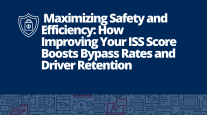Officials Seek More Traffic Enforcement For Trucks to Reduce Highway Crashes
This story appears in the Jan. 27 print edition of Transport Topics.
Traffic-enforcement inspections of trucks have been dwindling in recent years, even though safety officials say they are particularly useful in reducing highway crashes.
While the nation’s trucks underwent 747,738 safety inspections in the fourth quarter of 2013, just 10.5% were from traffic enforcements, according to Federal Motor Carrier Safety Administration data.
Traffic enforcements occur when an officer spots a truck operating improperly and then inspects the vehicle after pulling it over.
FMCSA said the remaining 89.5% of the fourth-quarter inspections resulted from random roadside checks, such as those often done at weigh stations.
Both types are part of the agency’s Motor Carrier Safety Assistance Program, or MCSAP, the results of which are posted online.
For all of fiscal 2013, which ended Sept. 30, there were 3.58 million inspections and 3.1 million, or 88.9%, were roadsides. Traffic-enforcement inspections took up the other 11.1%.
As recently as 2009, traffic-enforcement inspections accounted for more than 20% of the total.
“The focus of the inspectors appears to be at the scales, but it’s very dramatic to see how little of that has an effect on safety,” said Steven Bryan, CEO of Vigillo, a Portland, Ore.-based data analysis company specializing in truck safety.
Bryan recommends traffic-enforcement inspections.
“It’s well understood that bad behavior such as speeding is what leads to most accidents. Inspectors should focus on that,” he said.
But an agency spokesman said MCSAP data do not provide a complete picture of truck inspections.
“There is much traffic enforcement done that is not accompanied by an inspection,” said FMCSA spokesman Duane DeBruyne.
By law, funds that states receive from MCSAP can be used for traffic enforcement that is not associated with an inspection. For instance, some MCSAP money is used for enforcement of unsafe driving around trucks and buses in the Ticketing Aggressive Cars and Trucks (TACT) program.
Most of the money to fund inspections comes from the federal government, even though state inspectors do most of the work. In fiscal 2013, FMCSA spent $165 million on MCSAP grants to the states. The states added $40.9 million toward the roadside and traffic-enforcement inspections.
Also, only about 12,000 of more than a half-million law enforcement officers in the nation are certified to inspect commercial vehicles, DeBruyne said.
An agency study issued during 2013 documented the effectiveness of traffic-enforcement inspections over a three-year period ended Sept. 30, 2009. It showed that of the 10.4 million truck and bus inspections performed, 78.4% were roadsides and 21.6% were traffic enforcements.
Despite the slant toward roadside inspections, traffic enforcements generated 51.8% of the estimated crashes and injuries avoided and lives saved. Roadsides were responsible for 48.2%, even though they were done much more frequently, the study said.
“The focus, in some ways, seems to be on the number of inspections done, not the safety outcomes. The answer should be what prevents the most crashes and saves the most lives,” said Dave Osiecki, American Trucking Associations senior vice president of policy and regulatory affairs and an advocate of traffic-enforcement activity.
Stephen Keppler, executive director of the Commercial Vehicle Safety Alliance, said the FMCSA report illustrates the need for discussion, “but there are some questions on the data.”
Recording each law-enforcement event related to trucking is difficult, Keppler said. Issuing a ticket to a driver for speeding or unsafe driving involves stopping a truck, he added, but there might not be an inspection involved.
DeBruyne said that starting this year, the agency is working with states to capture all commercial vehicle-related traffic enforcements conducted under FMCSA grant programs — not just traffic enforcement accompanied by an inspection.
ATA’s Osiecki said increasing traffic-enforcement actions also could help improve the federal Compliance, Safety, Accountability program, which uses seven Behavioral Analysis and Safety Improvement Categories, or BASICs.
“Of all the BASICs, the unsafe driving category is the most effective at predicting the likelihood of a future crash. Traffic enforcement activity coupled with inspections feeds data to that BASIC,” he said. “If for no other reason, we should all want FMCSA and inspectors to populate that BASIC with as much useful data as possible.”


